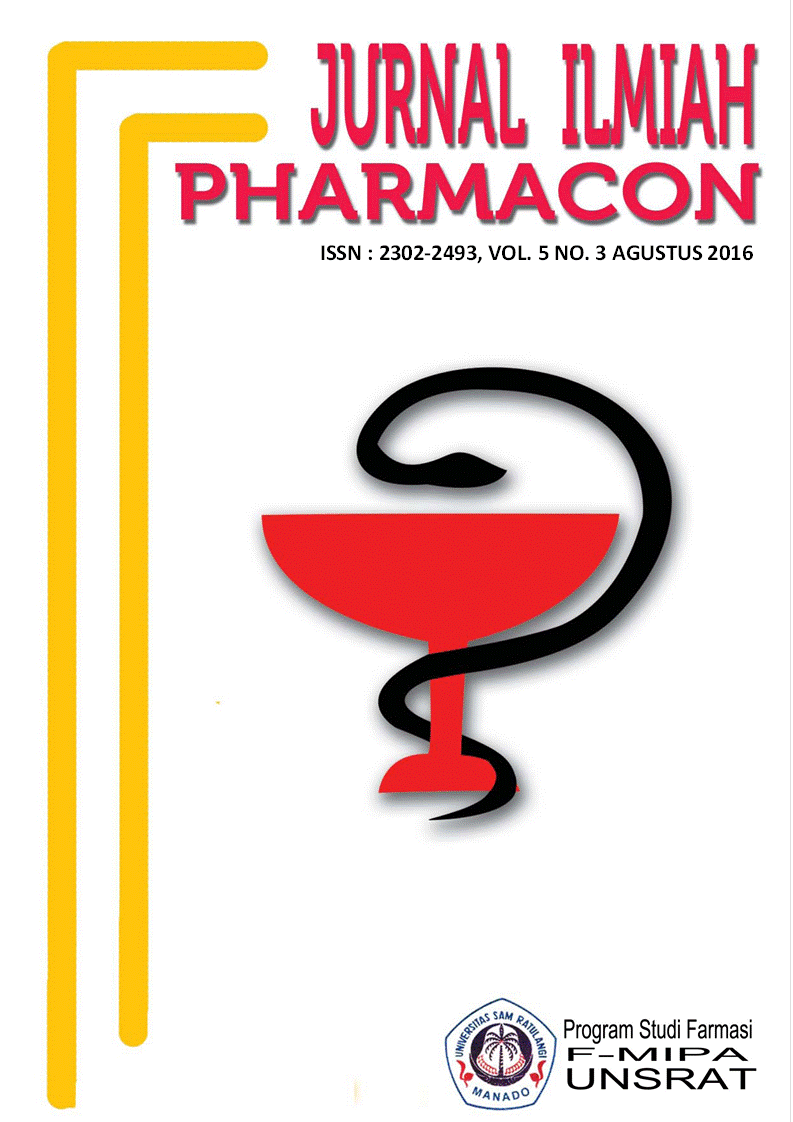UJI DAYA HAMBAT EKSTRAK DAUN MELINJO (Gnetum gnemon L.) TERHADAP PERTUMBUHAN BAKTERI Streptococcus mutans
DOI:
https://doi.org/10.35799/pha.5.2016.12954Abstract
UJI DAYA HAMBAT EKSTRAK DAUN MELINJO (Gnetum gnemon L.) TERHADAP PERTUMBUHAN BAKTERI Streptococcus mutans
Â
The Natalia C Taroreh1), Jimmy F.Rumampuk1), Krista Veronica Siagian 1)
1) Program Studi Pendidikan Dokter Gigi, Fakultas Kedokteran UNSRAT Manado, 95115
Â
ABSTRACT
Caries is the oral health problems most often occur in Indonesia, which is caused by several factors: the hosts, the substrate, microorganisms, and time. One of the leading causes of bacterial caries is Streptococcus mutans. Several studies of various types of herbs have been made to control the growth of harmful bacteria in the oral cavity. Plants in Indonesia is often used as a herbal plant material that leaves melinjo (Gnetum gnemon L) because melinjo leaves contain active compounds such as alkaloids, flavonoids, steroids and tannins that have the antibacterial effectivity. This study was aimed to explore the antibacterial effectivity extract of melinjo leaves against Streptococcus mutans. This study is an experimental research laboratory, with the design of post-test only control group design. This study is experimental with Kirby-bauer method using filter paper. Melinjo leaf samples were extracted by maceration method using ethanol 96%. Streptococcus mutans is a bacterium pure stock of F.MIPA Microbiology Laboratory of Pharmacy University of Sam Ratulangi.The results showed melinjo leaf extract (Gnetum gnemon L.) has antibacterial effectiveness in inhibiting the growth of Streptococcus mutans and inhibition zone formed by 10.6 mm.
Keywords: leaves melinjo (Gnetum gnemon L), Streptococcus mutans, inhibition zone
ABSTRAK
Karies merupakan masalah kesehatan gigi dan mulut yang paling sering terjadi di Indonesia, yang disebabkan oleh beberapa faktor yaitu host, substrat, mikroorganisme, dan waktu. Salah satu bakteri penyebab utama timbulnya karies yaitu Streptococcus mutans. Beberapa penelitian tentang berbagai jenis tumbuhan herbal telah dilakukan untuk mengendalikan pertumbuhan bakteri-bakteri yang merugikan di dalam rongga mulut. Tanaman di Indonesia yang sering digunakan sebagai bahan tumbuhan herbal yaitu daun melinjo (Gnetum gnemon L) karena daun melinjo memiliki kandungan senyawa aktif seperti alkaloid, flavonoid, steroid, dan tanin yang mempunyai efek antibakteri.Tujuan penelitian ini untuk mengetahui daya hambat ekstrak daun melinjo terhadap pertumbuhan bakteri Streptococcus mutans. Penelitian ini merupakan penelitian eksperimental laboratorium, dengan rancangan post-test only control group design. Metode pengujian yang digunakan dalam penelitian ini yaitu dengan menggunakan metode modifikasi Kirby-Bauer dengan menggunakan paper disk. Sampel daun melinjo diekstraksi dengan metode maserasi menggunakan pelarut etanol 96%. Bakteri Streptococcus mutans merupakan stok bakteri murni dari Laboratorium Mikrobiologi F.MIPA Farmasi Universitas Sam Ratulangi Manado. Hasil penelitian menunjukkan ekstrak daun melinjo (Gnetum gnemon L.) memiliki efektivitas antibakteri dalam menghambat pertumbuhan Streptococcus mutans dan zona hambat yang terbentuk sebesar 10,6 mm.
Kata kunci : daun melinjo (Gnetum gnemon L), Streptococcus mutans, zona hambat
Â
Downloads
Published
How to Cite
Issue
Section
License
Authors who publish with this journal agree to the following terms:
- Authors retain copyright and grant the journal right of first publication with the work simultaneously licensed under a Creative Commons Attribution-NonCommercial 4.0 International License that allows others to share the work with an acknowledgement of the work's authorship and initial publication in this journal.
- Authors are permitted and encouraged to post their work online (e.g., in institutional repositories or on their website) prior to and during the submission process, as it can lead to productive exchanges, as well as earlier and greater citation of published work (See The Effect of Open Access)










